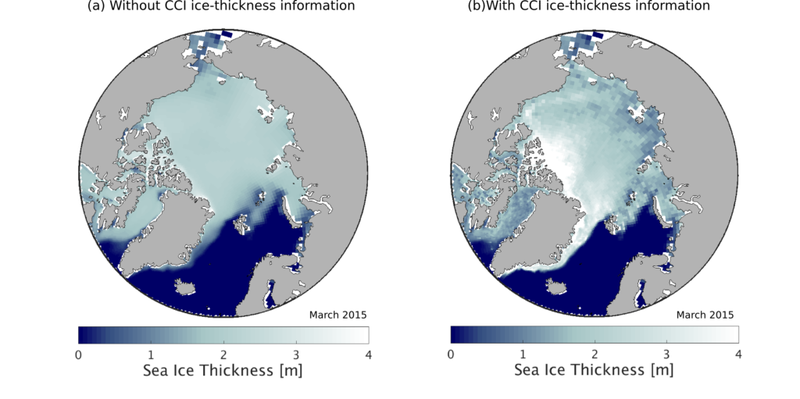A new dimension: The CCI sea-ice thickness data set
The sea-ice cover in both hemispheres is a key indicator and driver of climatic change. Over the past few decades, the area of Arctic sea ice in summer has for example decreased by about 50 %, raising prospects of an ice free Arctic Ocean during summer within a few decades.
The monitoring of sea-ice coverage since the late 1970 has become a landmark timeseries for the changing climate of our planet. However, so far we have largely been lacking information on the thinning of the ice cover. We have only been able to see how the area changes, but to estimate the total melting of the sea-ice cover, we need information on sea-ice thickness, too.
A new dataset of sea-ice thickness, produced by the ESA CCI Sea-ice team, now for the first time provides a consistent data set of sea-ice thickness during winter from two satellite missions (ESA Envisat & CryoSat) with coverage of the past 15 years. Within CMUG, we have carried out some first tests based on this data set, which is for example crucial to evaluate more robustly our large-scale model simulations of the sea-ice cover against observations.

Figure 1: A comparison of the simulated sea-ice thickness for March 2015 (a) without and (b) with the information provided by the new ESA CCI sea-ice thickness data set. (Model: MPI-ESM. Simulation: Felix Bunzel. Visualisation: Louisa Bell.)
In addition, we can now also exploit the ESA CCI sea-ice thickness data to obtain better seasonal forecasts of sea-ice coverage. The thickness information provides crucial information that allows us to better initialise our model simulations. As shown in the figure, in the past without any sea-ice thickness information, the model was initialised with a rather uniform ice thickness (panel a). Using the new sea-ice thickness data has now allowed us to more realistically initialise our model (panel b).
This then allows us to better forecast the possible sea-ice distribution at the end of summer. For example, it is quite likely that the thin ice off the coast of Siberia in the simulation with the new ice-thickness data will melt throughout summer, whereas in the simulation without ice-thickness information the ice in that area was possibly too thick to fully melt.
Hence, not only for model evaluation, but also for seasonal sea-ice forecasts the new ESA CCI sea-ice thickness data set is an important leap forward. Once this data set is more thoroughly tested and freely released to the scientific community, it will most certainly change the way in which we evaluate and initialise our sea ice simulations for years to come.
About the author

Dr. Dirk Notz leads the Research Group on Sea Ice in the Earth System at the Max Planck Institute for Meteorology. He and his group aim at better understanding the role of sea ice for the changing climate of our Earth. His work combines laboratory and field experiments with small-scale and large-scale modelling.

